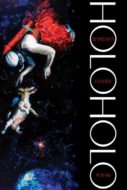 Barbara Hamby
Barbara Hamby
Holoholo
University of Pittsburgh Press
Reviewer: Lee Rossi
How to describe a book as filled with delights as Barbara Hamby’s Holoholo. Ostensibly a book of odes, these are not just poems of praise; she urges her readers to construe the term “ode” in the widest possible sense: as a “poetic stance, a poetic investigation of what it means to be a human being at any moment in time.”
Keats, of course, is one of her many co-conspirators in this late night jam, and indeed in “Ode on My Nightingale” her “little god” [the nightingale] tells us, “I am the cosmologist / of the atomic, high priest of everything / you never wanted to be . . . / your drinking water straight from the stream, / . . . I am the derivative of sin. O let me in.” The struggle is on for the soul of this poor soul, and only when everything in the cosmos (and the dictionary) is let in will she be at peace.
This openness to experience is replicated in the expansive syntax of these poems. One finds oneself wandering her sentences like Dante on his way to Heaven. In “Ode on Following My Mind,” we escort the poet not only through her waking but also her dreaming life, where she tours the Paris of her brain, “the Arc de Poésie and the Bistro de Chekhov / and the Jardin de Procrastibaking,” only to realize:
… when you’re born, your brain is medieval Paris
and then Baron Haussmann begins to build your celestial
cranial city with its Place de la Concorde,
which took years of meditation to clear, bulldozing the hovels
of your parent’s Baptist bugaloos …
“Holoholo” is a Hawaiian word that means “walking out with no destination in mind,” and these poems allow themselves that kind of freedom, a freedom which embraces the infinite variety of human experience, and language. I’m particularly fond of her “Ode to Yiddish.” She’s grateful, she tells us,
to my former boyfriend for the Yiddish that I pepper
my conversation with, and sometimes I get all
ver klempt and schmaltzy about those years we spent
in our vegetarian squalor …
But then she remembers the fights. Such fights they had!
… I thought he was schmendrik,
and he hated all my tchatchkes, and I couldn’t stand
his constant kvetching and he hated how big my tuches
was …
but now that he’s an alter cocker and I’m a bubbe, time
has erased so many of my grievances,
so I say shalom, old friend, time is a gonif, but sometimes
he steals the dreck we never needed anyway.
If we say the title of Hamby’s book a few times to ourselves (like a mantra), we realize that, in fact, it’s an echo: holo / holo. And we know that a mirror is a visual echo. So, on one hand, these are poems that mirror the poet’s world—America / herself / her wanderings—but is that all they strive for? Every encounter with reality is re-formed or enlivened by something we might call inspiration. “Inspire” comes from the Latin word to breathe, and we’ve already noted the breathiness of these poems, a breathiness which is Whitmanic (emphasis on the manic) out of Charles Olson and the Beats. Sentences run on and on, sometimes the length of these lengthy poems, but often at least 4 or 5 strophes.
Keats is here, and Whitman. And also the Emily Dickinson who wrote, “I am out with lanterns, looking for myself.” The search is on. Who is this poet? Who does she speak to? And to what end?
Hamby’s previous book Bird Odyssey wrestled with what it means (in our numbingly patriarchal culture) to be a woman, especially a woman writer. This volume too engages daddies big and small, whose lives and lifestyles depend on exploiting women and others. In “Ode to Driving on Venice Boulevard with Emily Dickinson,” she asks, “how does any woman become herself in this crazy world?” But it’s not just the world which frustrates a woman’s becoming herself; women too are “at war with their bodies and every missile / thrown from their own minds into the hurricane of their hearts.”
In “Ode on Going Holoholo and Getting Lost” she offers a prayer, for freedom and renewal:
… O let me always be lost in this storm of time,
may I turn every corner and see something I’ve never seen before,
see the world to me like a dragon with a mouth full
of torch ginger or a peony with a head of a thousand petals,
her pink shores and armada of clouds, each galleon
carrying all the gold of the summer when I was twelve,
the shimmer-slicked mornings and my salt-wracked breath.
So what, she declares, if this freedom is mostly imaginary; whether you’re twelve or a poet, summer is all the gold you need.
But maybe there are other answers. For this poet, no options are foreclosed. What about revolution? (Is it REAL, or is it METAPHOR; only the poet knows.) Consider “Ode on Fire,” in which she pictures herself as a clandestine revolutionary: “the cigarette girl with the bazooka of annihilation” “handing cigars to Big Daddys at the Tropicana while revolution / sneaks into Havana.”
Such riches in the language: the “bazooka of annihilation” reminding me of Ginsberg’s “hydrogen jukebox,” the rhyming (Tropicana / Havana), and that wonderful pun—not only is the poem about fire, but the poet sets herself as on fire: “with Jehovah, with Mohammed / with night bombing drones over Syria.” Re-tooling the tools that the culture gives her (“our word hoard, our dictionary / of love and conflagration, our bible of fallen walls and trumpets, / … setting myself on fire with nickel bags of hooey,” like some Vietnamese Buddhist), Hamby offers her readers a beacon in this darkening world.

